Effective Business Communication: Skills Assessment and Action Plan
VerifiedAdded on 2020/05/16
|20
|5290
|233
Report
AI Summary
This report presents a comprehensive self-assessment of the student's effective business communication skills, encompassing verbal and non-verbal communication, and team dynamics. The report begins with a diagnosis and reflection based on psychometric tests, identifying key communication issues such as discomfort in large groups and difficulty suggesting ideas under pressure. A literature review explores the importance of communication, including verbal and non-verbal aspects, and relevant communication theories such as Newcomb's and Shannon-Weaver models. The report also examines team dynamics and factors impacting group performance. Finally, an action plan is proposed to address the identified communication issues and improve overall effectiveness in professional interactions. The analysis includes reflections on recent professional interactions, providing context for the assessment and highlighting areas for improvement in practical settings. The student aims to enhance their communication skills to become a more effective team lead and contributor within their organization.
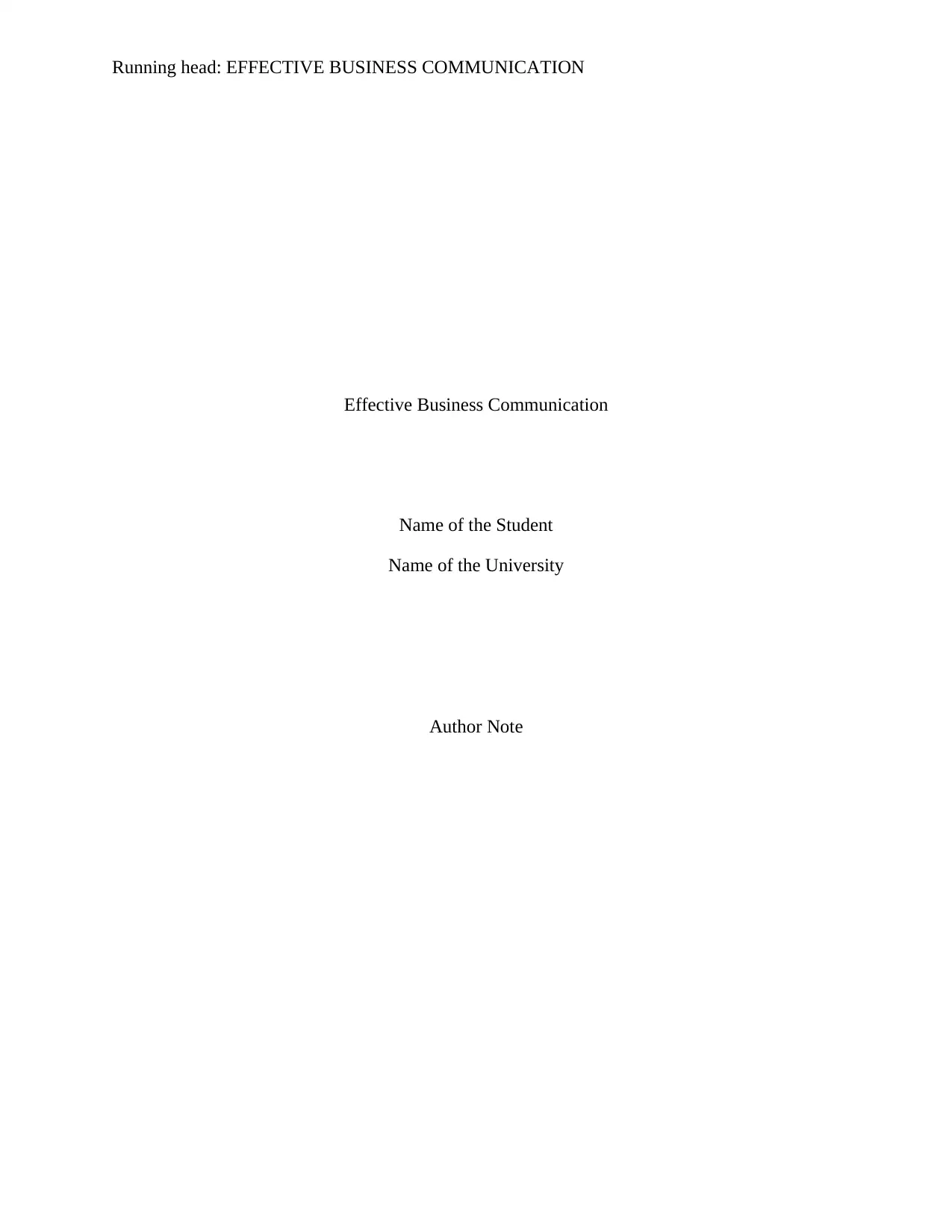
Running head: EFFECTIVE BUSINESS COMMUNICATION
Effective Business Communication
Name of the Student
Name of the University
Author Note
Effective Business Communication
Name of the Student
Name of the University
Author Note
Paraphrase This Document
Need a fresh take? Get an instant paraphrase of this document with our AI Paraphraser
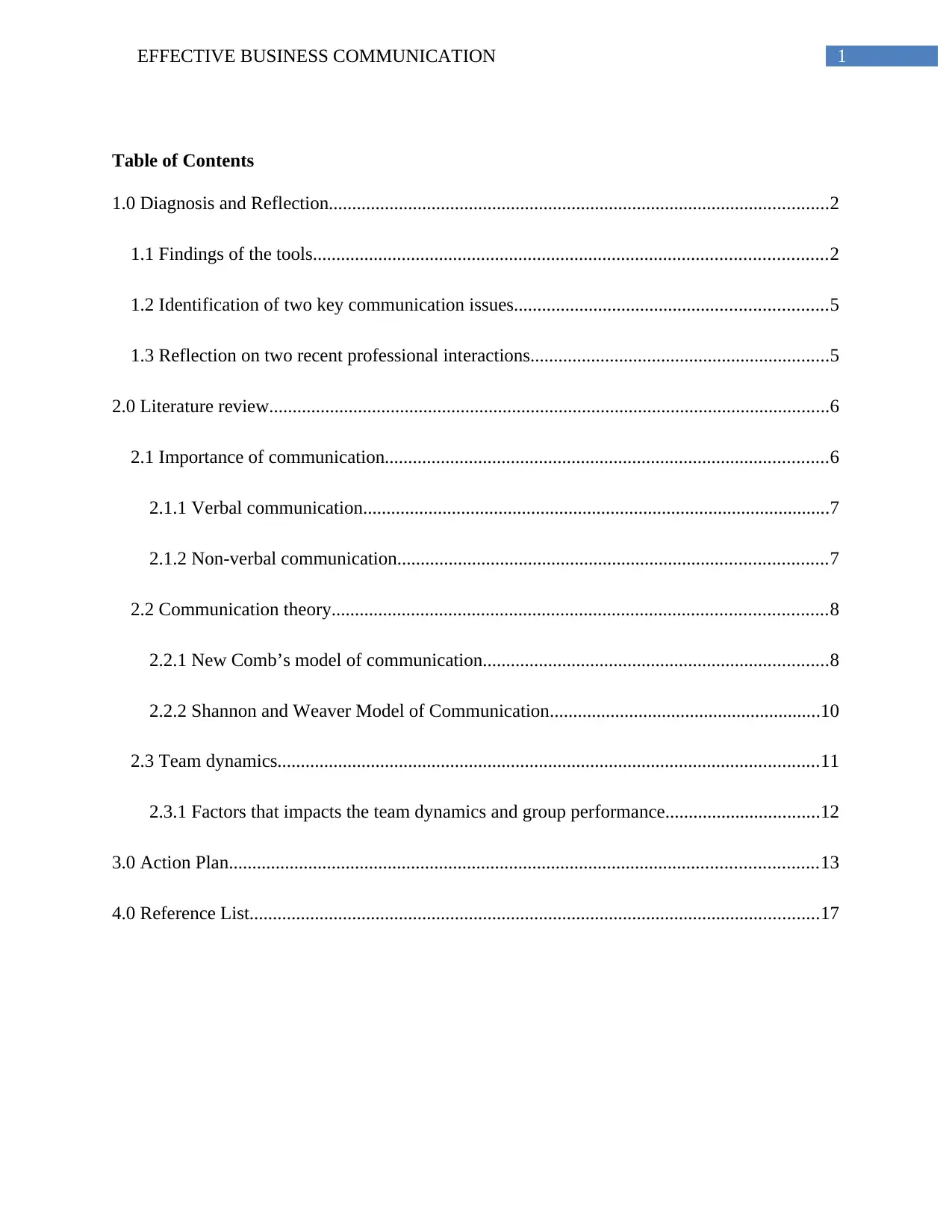
1EFFECTIVE BUSINESS COMMUNICATION
Table of Contents
1.0 Diagnosis and Reflection...........................................................................................................2
1.1 Findings of the tools..............................................................................................................2
1.2 Identification of two key communication issues...................................................................5
1.3 Reflection on two recent professional interactions................................................................5
2.0 Literature review........................................................................................................................6
2.1 Importance of communication...............................................................................................6
2.1.1 Verbal communication....................................................................................................7
2.1.2 Non-verbal communication............................................................................................7
2.2 Communication theory..........................................................................................................8
2.2.1 New Comb’s model of communication..........................................................................8
2.2.2 Shannon and Weaver Model of Communication..........................................................10
2.3 Team dynamics....................................................................................................................11
2.3.1 Factors that impacts the team dynamics and group performance.................................12
3.0 Action Plan..............................................................................................................................13
4.0 Reference List..........................................................................................................................17
Table of Contents
1.0 Diagnosis and Reflection...........................................................................................................2
1.1 Findings of the tools..............................................................................................................2
1.2 Identification of two key communication issues...................................................................5
1.3 Reflection on two recent professional interactions................................................................5
2.0 Literature review........................................................................................................................6
2.1 Importance of communication...............................................................................................6
2.1.1 Verbal communication....................................................................................................7
2.1.2 Non-verbal communication............................................................................................7
2.2 Communication theory..........................................................................................................8
2.2.1 New Comb’s model of communication..........................................................................8
2.2.2 Shannon and Weaver Model of Communication..........................................................10
2.3 Team dynamics....................................................................................................................11
2.3.1 Factors that impacts the team dynamics and group performance.................................12
3.0 Action Plan..............................................................................................................................13
4.0 Reference List..........................................................................................................................17
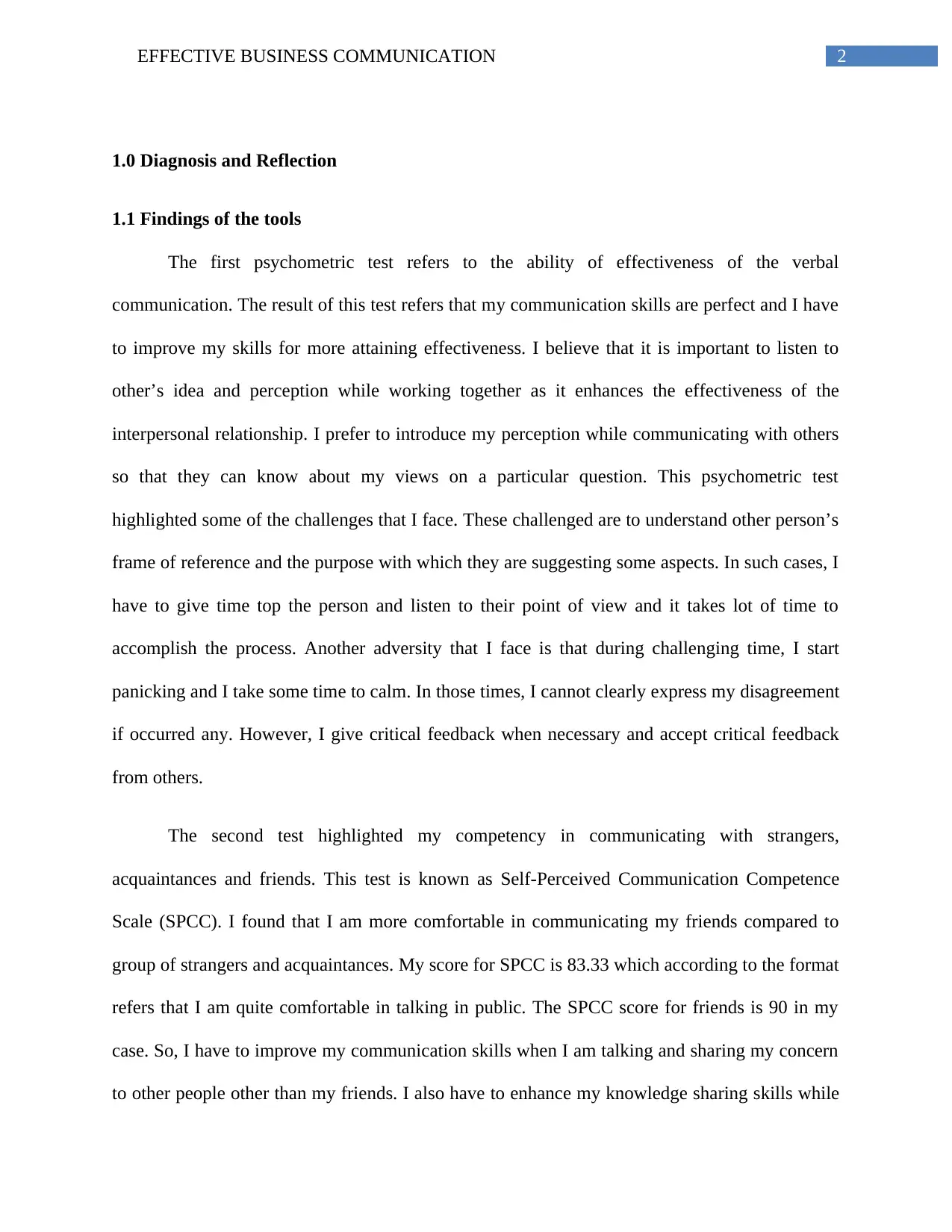
2EFFECTIVE BUSINESS COMMUNICATION
1.0 Diagnosis and Reflection
1.1 Findings of the tools
The first psychometric test refers to the ability of effectiveness of the verbal
communication. The result of this test refers that my communication skills are perfect and I have
to improve my skills for more attaining effectiveness. I believe that it is important to listen to
other’s idea and perception while working together as it enhances the effectiveness of the
interpersonal relationship. I prefer to introduce my perception while communicating with others
so that they can know about my views on a particular question. This psychometric test
highlighted some of the challenges that I face. These challenged are to understand other person’s
frame of reference and the purpose with which they are suggesting some aspects. In such cases, I
have to give time top the person and listen to their point of view and it takes lot of time to
accomplish the process. Another adversity that I face is that during challenging time, I start
panicking and I take some time to calm. In those times, I cannot clearly express my disagreement
if occurred any. However, I give critical feedback when necessary and accept critical feedback
from others.
The second test highlighted my competency in communicating with strangers,
acquaintances and friends. This test is known as Self-Perceived Communication Competence
Scale (SPCC). I found that I am more comfortable in communicating my friends compared to
group of strangers and acquaintances. My score for SPCC is 83.33 which according to the format
refers that I am quite comfortable in talking in public. The SPCC score for friends is 90 in my
case. So, I have to improve my communication skills when I am talking and sharing my concern
to other people other than my friends. I also have to enhance my knowledge sharing skills while
1.0 Diagnosis and Reflection
1.1 Findings of the tools
The first psychometric test refers to the ability of effectiveness of the verbal
communication. The result of this test refers that my communication skills are perfect and I have
to improve my skills for more attaining effectiveness. I believe that it is important to listen to
other’s idea and perception while working together as it enhances the effectiveness of the
interpersonal relationship. I prefer to introduce my perception while communicating with others
so that they can know about my views on a particular question. This psychometric test
highlighted some of the challenges that I face. These challenged are to understand other person’s
frame of reference and the purpose with which they are suggesting some aspects. In such cases, I
have to give time top the person and listen to their point of view and it takes lot of time to
accomplish the process. Another adversity that I face is that during challenging time, I start
panicking and I take some time to calm. In those times, I cannot clearly express my disagreement
if occurred any. However, I give critical feedback when necessary and accept critical feedback
from others.
The second test highlighted my competency in communicating with strangers,
acquaintances and friends. This test is known as Self-Perceived Communication Competence
Scale (SPCC). I found that I am more comfortable in communicating my friends compared to
group of strangers and acquaintances. My score for SPCC is 83.33 which according to the format
refers that I am quite comfortable in talking in public. The SPCC score for friends is 90 in my
case. So, I have to improve my communication skills when I am talking and sharing my concern
to other people other than my friends. I also have to enhance my knowledge sharing skills while
⊘ This is a preview!⊘
Do you want full access?
Subscribe today to unlock all pages.

Trusted by 1+ million students worldwide
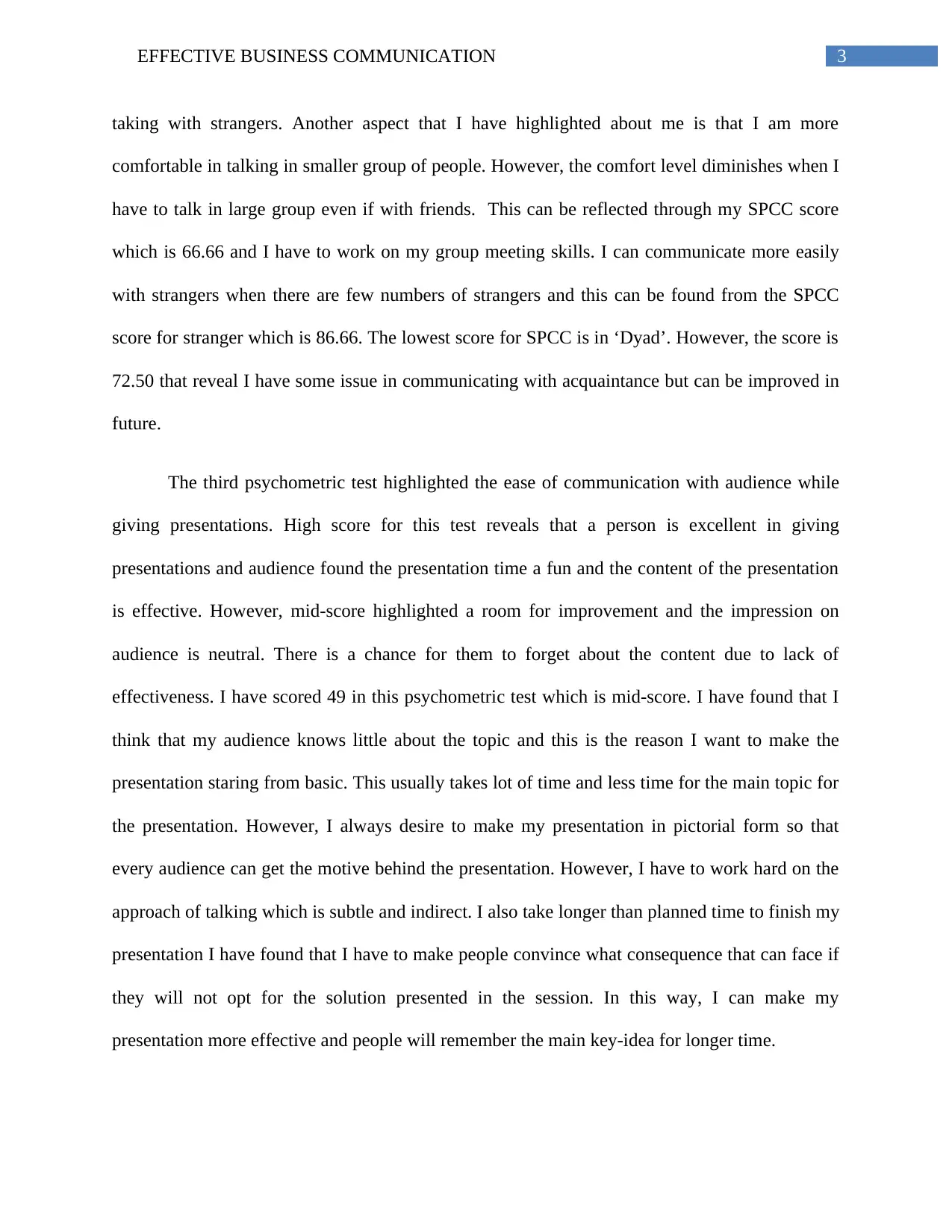
3EFFECTIVE BUSINESS COMMUNICATION
taking with strangers. Another aspect that I have highlighted about me is that I am more
comfortable in talking in smaller group of people. However, the comfort level diminishes when I
have to talk in large group even if with friends. This can be reflected through my SPCC score
which is 66.66 and I have to work on my group meeting skills. I can communicate more easily
with strangers when there are few numbers of strangers and this can be found from the SPCC
score for stranger which is 86.66. The lowest score for SPCC is in ‘Dyad’. However, the score is
72.50 that reveal I have some issue in communicating with acquaintance but can be improved in
future.
The third psychometric test highlighted the ease of communication with audience while
giving presentations. High score for this test reveals that a person is excellent in giving
presentations and audience found the presentation time a fun and the content of the presentation
is effective. However, mid-score highlighted a room for improvement and the impression on
audience is neutral. There is a chance for them to forget about the content due to lack of
effectiveness. I have scored 49 in this psychometric test which is mid-score. I have found that I
think that my audience knows little about the topic and this is the reason I want to make the
presentation staring from basic. This usually takes lot of time and less time for the main topic for
the presentation. However, I always desire to make my presentation in pictorial form so that
every audience can get the motive behind the presentation. However, I have to work hard on the
approach of talking which is subtle and indirect. I also take longer than planned time to finish my
presentation I have found that I have to make people convince what consequence that can face if
they will not opt for the solution presented in the session. In this way, I can make my
presentation more effective and people will remember the main key-idea for longer time.
taking with strangers. Another aspect that I have highlighted about me is that I am more
comfortable in talking in smaller group of people. However, the comfort level diminishes when I
have to talk in large group even if with friends. This can be reflected through my SPCC score
which is 66.66 and I have to work on my group meeting skills. I can communicate more easily
with strangers when there are few numbers of strangers and this can be found from the SPCC
score for stranger which is 86.66. The lowest score for SPCC is in ‘Dyad’. However, the score is
72.50 that reveal I have some issue in communicating with acquaintance but can be improved in
future.
The third psychometric test highlighted the ease of communication with audience while
giving presentations. High score for this test reveals that a person is excellent in giving
presentations and audience found the presentation time a fun and the content of the presentation
is effective. However, mid-score highlighted a room for improvement and the impression on
audience is neutral. There is a chance for them to forget about the content due to lack of
effectiveness. I have scored 49 in this psychometric test which is mid-score. I have found that I
think that my audience knows little about the topic and this is the reason I want to make the
presentation staring from basic. This usually takes lot of time and less time for the main topic for
the presentation. However, I always desire to make my presentation in pictorial form so that
every audience can get the motive behind the presentation. However, I have to work hard on the
approach of talking which is subtle and indirect. I also take longer than planned time to finish my
presentation I have found that I have to make people convince what consequence that can face if
they will not opt for the solution presented in the session. In this way, I can make my
presentation more effective and people will remember the main key-idea for longer time.
Paraphrase This Document
Need a fresh take? Get an instant paraphrase of this document with our AI Paraphraser
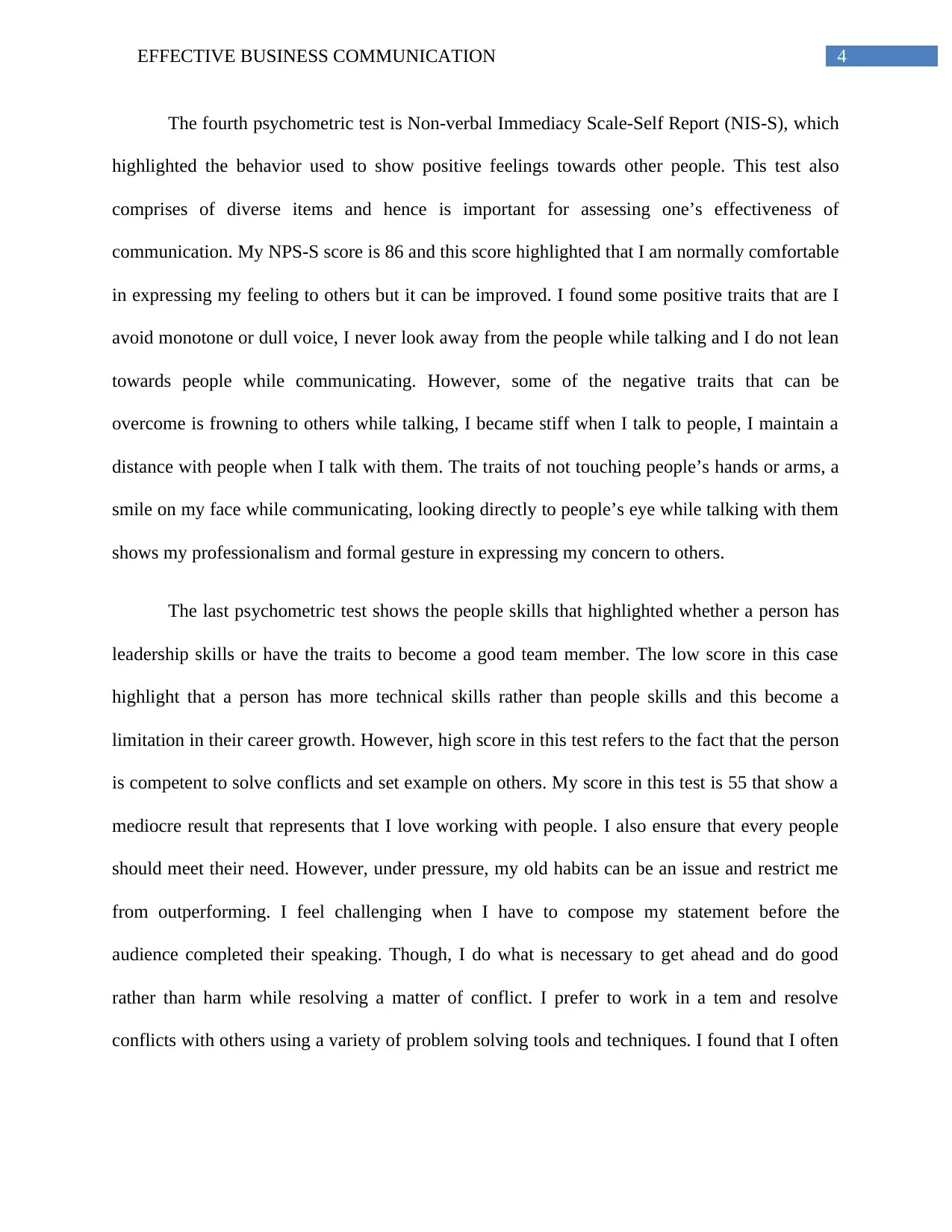
4EFFECTIVE BUSINESS COMMUNICATION
The fourth psychometric test is Non-verbal Immediacy Scale-Self Report (NIS-S), which
highlighted the behavior used to show positive feelings towards other people. This test also
comprises of diverse items and hence is important for assessing one’s effectiveness of
communication. My NPS-S score is 86 and this score highlighted that I am normally comfortable
in expressing my feeling to others but it can be improved. I found some positive traits that are I
avoid monotone or dull voice, I never look away from the people while talking and I do not lean
towards people while communicating. However, some of the negative traits that can be
overcome is frowning to others while talking, I became stiff when I talk to people, I maintain a
distance with people when I talk with them. The traits of not touching people’s hands or arms, a
smile on my face while communicating, looking directly to people’s eye while talking with them
shows my professionalism and formal gesture in expressing my concern to others.
The last psychometric test shows the people skills that highlighted whether a person has
leadership skills or have the traits to become a good team member. The low score in this case
highlight that a person has more technical skills rather than people skills and this become a
limitation in their career growth. However, high score in this test refers to the fact that the person
is competent to solve conflicts and set example on others. My score in this test is 55 that show a
mediocre result that represents that I love working with people. I also ensure that every people
should meet their need. However, under pressure, my old habits can be an issue and restrict me
from outperforming. I feel challenging when I have to compose my statement before the
audience completed their speaking. Though, I do what is necessary to get ahead and do good
rather than harm while resolving a matter of conflict. I prefer to work in a tem and resolve
conflicts with others using a variety of problem solving tools and techniques. I found that I often
The fourth psychometric test is Non-verbal Immediacy Scale-Self Report (NIS-S), which
highlighted the behavior used to show positive feelings towards other people. This test also
comprises of diverse items and hence is important for assessing one’s effectiveness of
communication. My NPS-S score is 86 and this score highlighted that I am normally comfortable
in expressing my feeling to others but it can be improved. I found some positive traits that are I
avoid monotone or dull voice, I never look away from the people while talking and I do not lean
towards people while communicating. However, some of the negative traits that can be
overcome is frowning to others while talking, I became stiff when I talk to people, I maintain a
distance with people when I talk with them. The traits of not touching people’s hands or arms, a
smile on my face while communicating, looking directly to people’s eye while talking with them
shows my professionalism and formal gesture in expressing my concern to others.
The last psychometric test shows the people skills that highlighted whether a person has
leadership skills or have the traits to become a good team member. The low score in this case
highlight that a person has more technical skills rather than people skills and this become a
limitation in their career growth. However, high score in this test refers to the fact that the person
is competent to solve conflicts and set example on others. My score in this test is 55 that show a
mediocre result that represents that I love working with people. I also ensure that every people
should meet their need. However, under pressure, my old habits can be an issue and restrict me
from outperforming. I feel challenging when I have to compose my statement before the
audience completed their speaking. Though, I do what is necessary to get ahead and do good
rather than harm while resolving a matter of conflict. I prefer to work in a tem and resolve
conflicts with others using a variety of problem solving tools and techniques. I found that I often
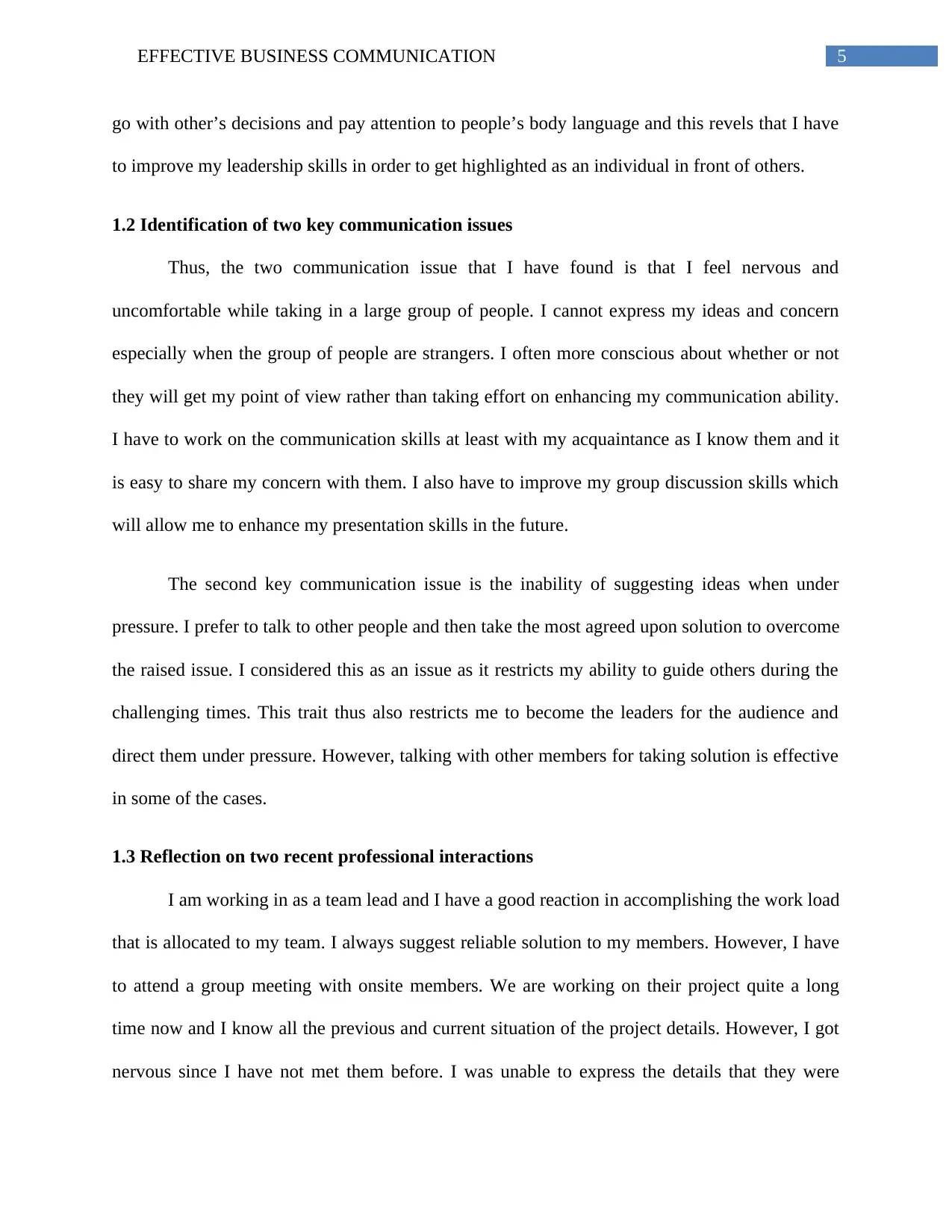
5EFFECTIVE BUSINESS COMMUNICATION
go with other’s decisions and pay attention to people’s body language and this revels that I have
to improve my leadership skills in order to get highlighted as an individual in front of others.
1.2 Identification of two key communication issues
Thus, the two communication issue that I have found is that I feel nervous and
uncomfortable while taking in a large group of people. I cannot express my ideas and concern
especially when the group of people are strangers. I often more conscious about whether or not
they will get my point of view rather than taking effort on enhancing my communication ability.
I have to work on the communication skills at least with my acquaintance as I know them and it
is easy to share my concern with them. I also have to improve my group discussion skills which
will allow me to enhance my presentation skills in the future.
The second key communication issue is the inability of suggesting ideas when under
pressure. I prefer to talk to other people and then take the most agreed upon solution to overcome
the raised issue. I considered this as an issue as it restricts my ability to guide others during the
challenging times. This trait thus also restricts me to become the leaders for the audience and
direct them under pressure. However, talking with other members for taking solution is effective
in some of the cases.
1.3 Reflection on two recent professional interactions
I am working in as a team lead and I have a good reaction in accomplishing the work load
that is allocated to my team. I always suggest reliable solution to my members. However, I have
to attend a group meeting with onsite members. We are working on their project quite a long
time now and I know all the previous and current situation of the project details. However, I got
nervous since I have not met them before. I was unable to express the details that they were
go with other’s decisions and pay attention to people’s body language and this revels that I have
to improve my leadership skills in order to get highlighted as an individual in front of others.
1.2 Identification of two key communication issues
Thus, the two communication issue that I have found is that I feel nervous and
uncomfortable while taking in a large group of people. I cannot express my ideas and concern
especially when the group of people are strangers. I often more conscious about whether or not
they will get my point of view rather than taking effort on enhancing my communication ability.
I have to work on the communication skills at least with my acquaintance as I know them and it
is easy to share my concern with them. I also have to improve my group discussion skills which
will allow me to enhance my presentation skills in the future.
The second key communication issue is the inability of suggesting ideas when under
pressure. I prefer to talk to other people and then take the most agreed upon solution to overcome
the raised issue. I considered this as an issue as it restricts my ability to guide others during the
challenging times. This trait thus also restricts me to become the leaders for the audience and
direct them under pressure. However, talking with other members for taking solution is effective
in some of the cases.
1.3 Reflection on two recent professional interactions
I am working in as a team lead and I have a good reaction in accomplishing the work load
that is allocated to my team. I always suggest reliable solution to my members. However, I have
to attend a group meeting with onsite members. We are working on their project quite a long
time now and I know all the previous and current situation of the project details. However, I got
nervous since I have not met them before. I was unable to express the details that they were
⊘ This is a preview!⊘
Do you want full access?
Subscribe today to unlock all pages.

Trusted by 1+ million students worldwide
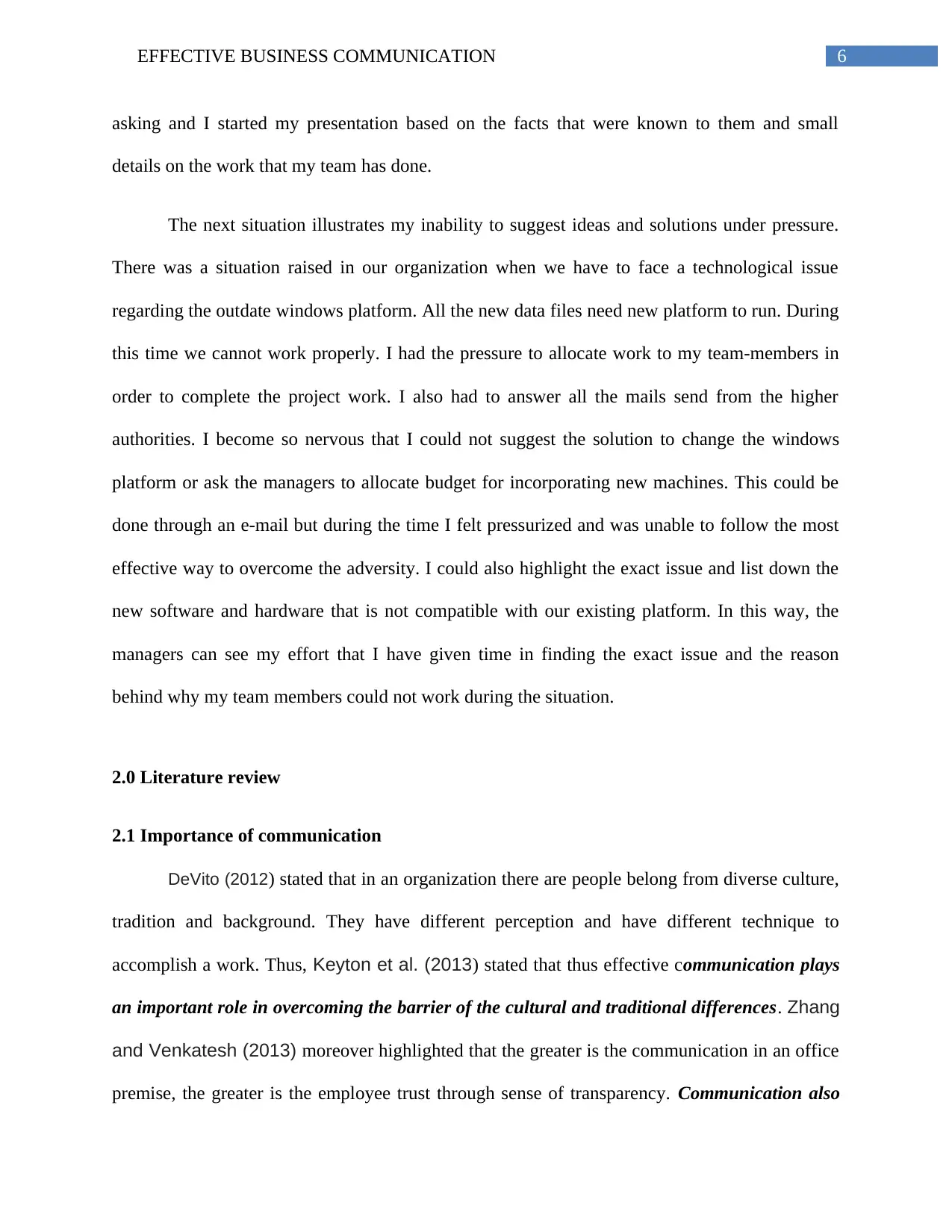
6EFFECTIVE BUSINESS COMMUNICATION
asking and I started my presentation based on the facts that were known to them and small
details on the work that my team has done.
The next situation illustrates my inability to suggest ideas and solutions under pressure.
There was a situation raised in our organization when we have to face a technological issue
regarding the outdate windows platform. All the new data files need new platform to run. During
this time we cannot work properly. I had the pressure to allocate work to my team-members in
order to complete the project work. I also had to answer all the mails send from the higher
authorities. I become so nervous that I could not suggest the solution to change the windows
platform or ask the managers to allocate budget for incorporating new machines. This could be
done through an e-mail but during the time I felt pressurized and was unable to follow the most
effective way to overcome the adversity. I could also highlight the exact issue and list down the
new software and hardware that is not compatible with our existing platform. In this way, the
managers can see my effort that I have given time in finding the exact issue and the reason
behind why my team members could not work during the situation.
2.0 Literature review
2.1 Importance of communication
DeVito (2012) stated that in an organization there are people belong from diverse culture,
tradition and background. They have different perception and have different technique to
accomplish a work. Thus, Keyton et al. (2013) stated that thus effective communication plays
an important role in overcoming the barrier of the cultural and traditional differences. Zhang
and Venkatesh (2013) moreover highlighted that the greater is the communication in an office
premise, the greater is the employee trust through sense of transparency. Communication also
asking and I started my presentation based on the facts that were known to them and small
details on the work that my team has done.
The next situation illustrates my inability to suggest ideas and solutions under pressure.
There was a situation raised in our organization when we have to face a technological issue
regarding the outdate windows platform. All the new data files need new platform to run. During
this time we cannot work properly. I had the pressure to allocate work to my team-members in
order to complete the project work. I also had to answer all the mails send from the higher
authorities. I become so nervous that I could not suggest the solution to change the windows
platform or ask the managers to allocate budget for incorporating new machines. This could be
done through an e-mail but during the time I felt pressurized and was unable to follow the most
effective way to overcome the adversity. I could also highlight the exact issue and list down the
new software and hardware that is not compatible with our existing platform. In this way, the
managers can see my effort that I have given time in finding the exact issue and the reason
behind why my team members could not work during the situation.
2.0 Literature review
2.1 Importance of communication
DeVito (2012) stated that in an organization there are people belong from diverse culture,
tradition and background. They have different perception and have different technique to
accomplish a work. Thus, Keyton et al. (2013) stated that thus effective communication plays
an important role in overcoming the barrier of the cultural and traditional differences. Zhang
and Venkatesh (2013) moreover highlighted that the greater is the communication in an office
premise, the greater is the employee trust through sense of transparency. Communication also
Paraphrase This Document
Need a fresh take? Get an instant paraphrase of this document with our AI Paraphraser
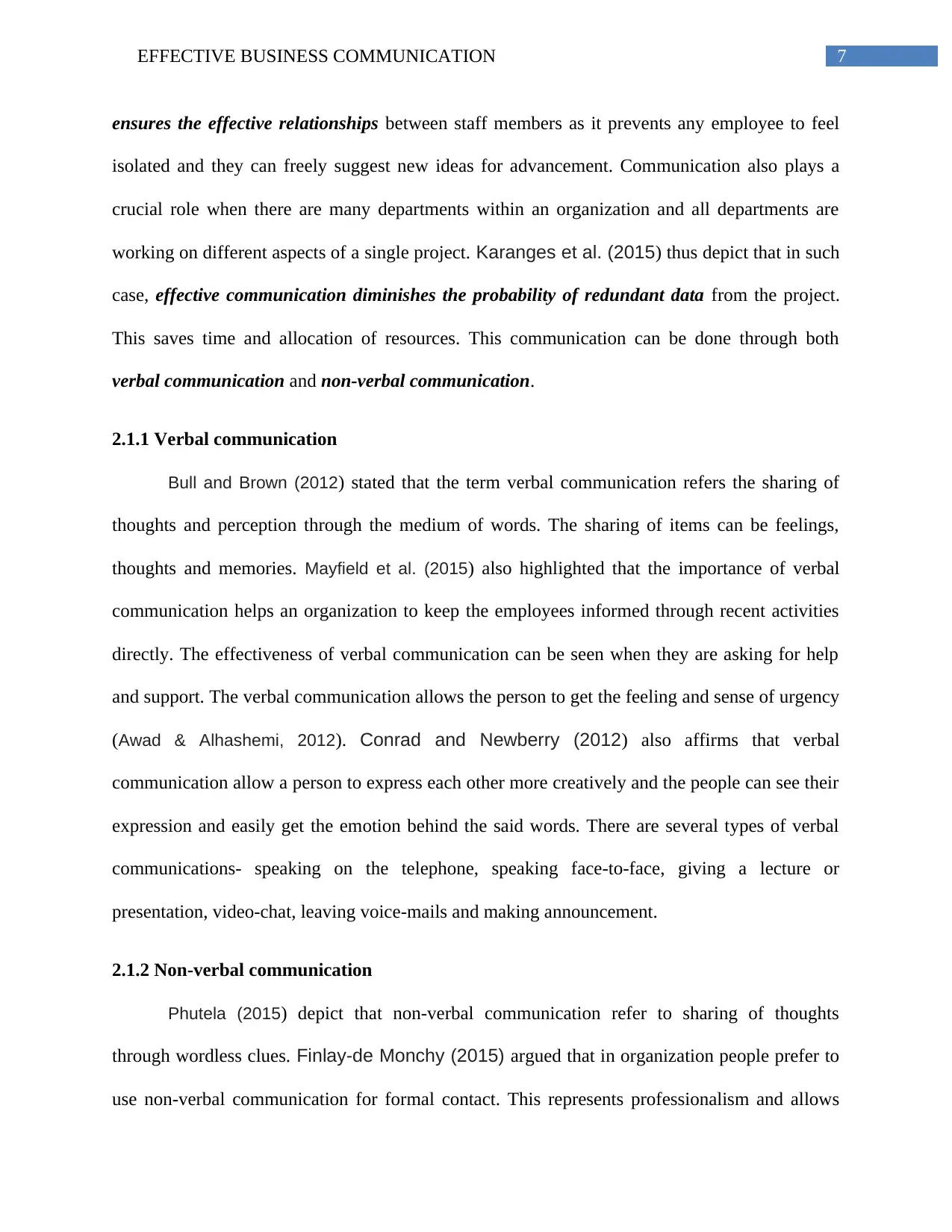
7EFFECTIVE BUSINESS COMMUNICATION
ensures the effective relationships between staff members as it prevents any employee to feel
isolated and they can freely suggest new ideas for advancement. Communication also plays a
crucial role when there are many departments within an organization and all departments are
working on different aspects of a single project. Karanges et al. (2015) thus depict that in such
case, effective communication diminishes the probability of redundant data from the project.
This saves time and allocation of resources. This communication can be done through both
verbal communication and non-verbal communication.
2.1.1 Verbal communication
Bull and Brown (2012) stated that the term verbal communication refers the sharing of
thoughts and perception through the medium of words. The sharing of items can be feelings,
thoughts and memories. Mayfield et al. (2015) also highlighted that the importance of verbal
communication helps an organization to keep the employees informed through recent activities
directly. The effectiveness of verbal communication can be seen when they are asking for help
and support. The verbal communication allows the person to get the feeling and sense of urgency
(Awad & Alhashemi, 2012). Conrad and Newberry (2012) also affirms that verbal
communication allow a person to express each other more creatively and the people can see their
expression and easily get the emotion behind the said words. There are several types of verbal
communications- speaking on the telephone, speaking face-to-face, giving a lecture or
presentation, video-chat, leaving voice-mails and making announcement.
2.1.2 Non-verbal communication
Phutela (2015) depict that non-verbal communication refer to sharing of thoughts
through wordless clues. Finlay-de Monchy (2015) argued that in organization people prefer to
use non-verbal communication for formal contact. This represents professionalism and allows
ensures the effective relationships between staff members as it prevents any employee to feel
isolated and they can freely suggest new ideas for advancement. Communication also plays a
crucial role when there are many departments within an organization and all departments are
working on different aspects of a single project. Karanges et al. (2015) thus depict that in such
case, effective communication diminishes the probability of redundant data from the project.
This saves time and allocation of resources. This communication can be done through both
verbal communication and non-verbal communication.
2.1.1 Verbal communication
Bull and Brown (2012) stated that the term verbal communication refers the sharing of
thoughts and perception through the medium of words. The sharing of items can be feelings,
thoughts and memories. Mayfield et al. (2015) also highlighted that the importance of verbal
communication helps an organization to keep the employees informed through recent activities
directly. The effectiveness of verbal communication can be seen when they are asking for help
and support. The verbal communication allows the person to get the feeling and sense of urgency
(Awad & Alhashemi, 2012). Conrad and Newberry (2012) also affirms that verbal
communication allow a person to express each other more creatively and the people can see their
expression and easily get the emotion behind the said words. There are several types of verbal
communications- speaking on the telephone, speaking face-to-face, giving a lecture or
presentation, video-chat, leaving voice-mails and making announcement.
2.1.2 Non-verbal communication
Phutela (2015) depict that non-verbal communication refer to sharing of thoughts
through wordless clues. Finlay-de Monchy (2015) argued that in organization people prefer to
use non-verbal communication for formal contact. This represents professionalism and allows
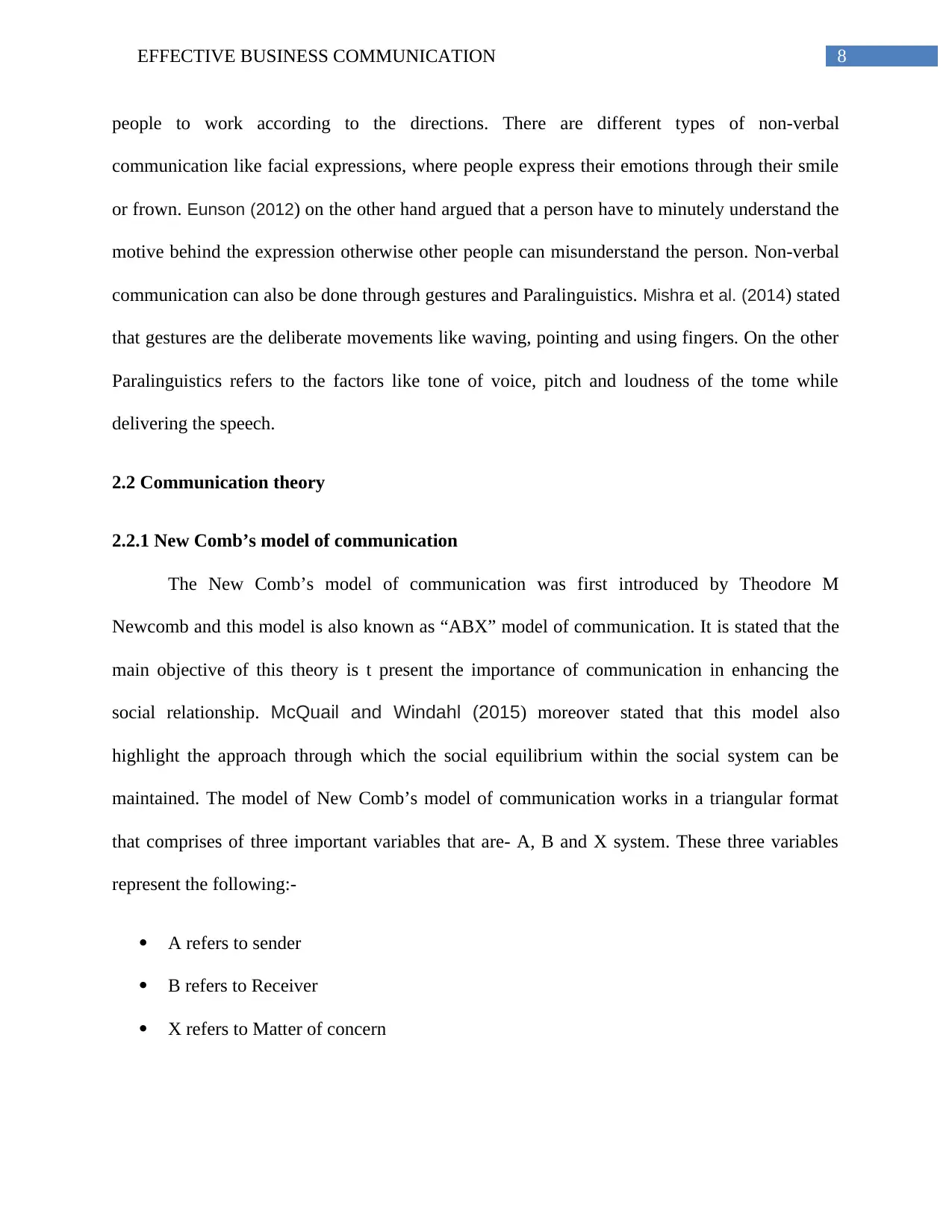
8EFFECTIVE BUSINESS COMMUNICATION
people to work according to the directions. There are different types of non-verbal
communication like facial expressions, where people express their emotions through their smile
or frown. Eunson (2012) on the other hand argued that a person have to minutely understand the
motive behind the expression otherwise other people can misunderstand the person. Non-verbal
communication can also be done through gestures and Paralinguistics. Mishra et al. (2014) stated
that gestures are the deliberate movements like waving, pointing and using fingers. On the other
Paralinguistics refers to the factors like tone of voice, pitch and loudness of the tome while
delivering the speech.
2.2 Communication theory
2.2.1 New Comb’s model of communication
The New Comb’s model of communication was first introduced by Theodore M
Newcomb and this model is also known as “ABX” model of communication. It is stated that the
main objective of this theory is t present the importance of communication in enhancing the
social relationship. McQuail and Windahl (2015) moreover stated that this model also
highlight the approach through which the social equilibrium within the social system can be
maintained. The model of New Comb’s model of communication works in a triangular format
that comprises of three important variables that are- A, B and X system. These three variables
represent the following:-
A refers to sender
B refers to Receiver
X refers to Matter of concern
people to work according to the directions. There are different types of non-verbal
communication like facial expressions, where people express their emotions through their smile
or frown. Eunson (2012) on the other hand argued that a person have to minutely understand the
motive behind the expression otherwise other people can misunderstand the person. Non-verbal
communication can also be done through gestures and Paralinguistics. Mishra et al. (2014) stated
that gestures are the deliberate movements like waving, pointing and using fingers. On the other
Paralinguistics refers to the factors like tone of voice, pitch and loudness of the tome while
delivering the speech.
2.2 Communication theory
2.2.1 New Comb’s model of communication
The New Comb’s model of communication was first introduced by Theodore M
Newcomb and this model is also known as “ABX” model of communication. It is stated that the
main objective of this theory is t present the importance of communication in enhancing the
social relationship. McQuail and Windahl (2015) moreover stated that this model also
highlight the approach through which the social equilibrium within the social system can be
maintained. The model of New Comb’s model of communication works in a triangular format
that comprises of three important variables that are- A, B and X system. These three variables
represent the following:-
A refers to sender
B refers to Receiver
X refers to Matter of concern
⊘ This is a preview!⊘
Do you want full access?
Subscribe today to unlock all pages.

Trusted by 1+ million students worldwide
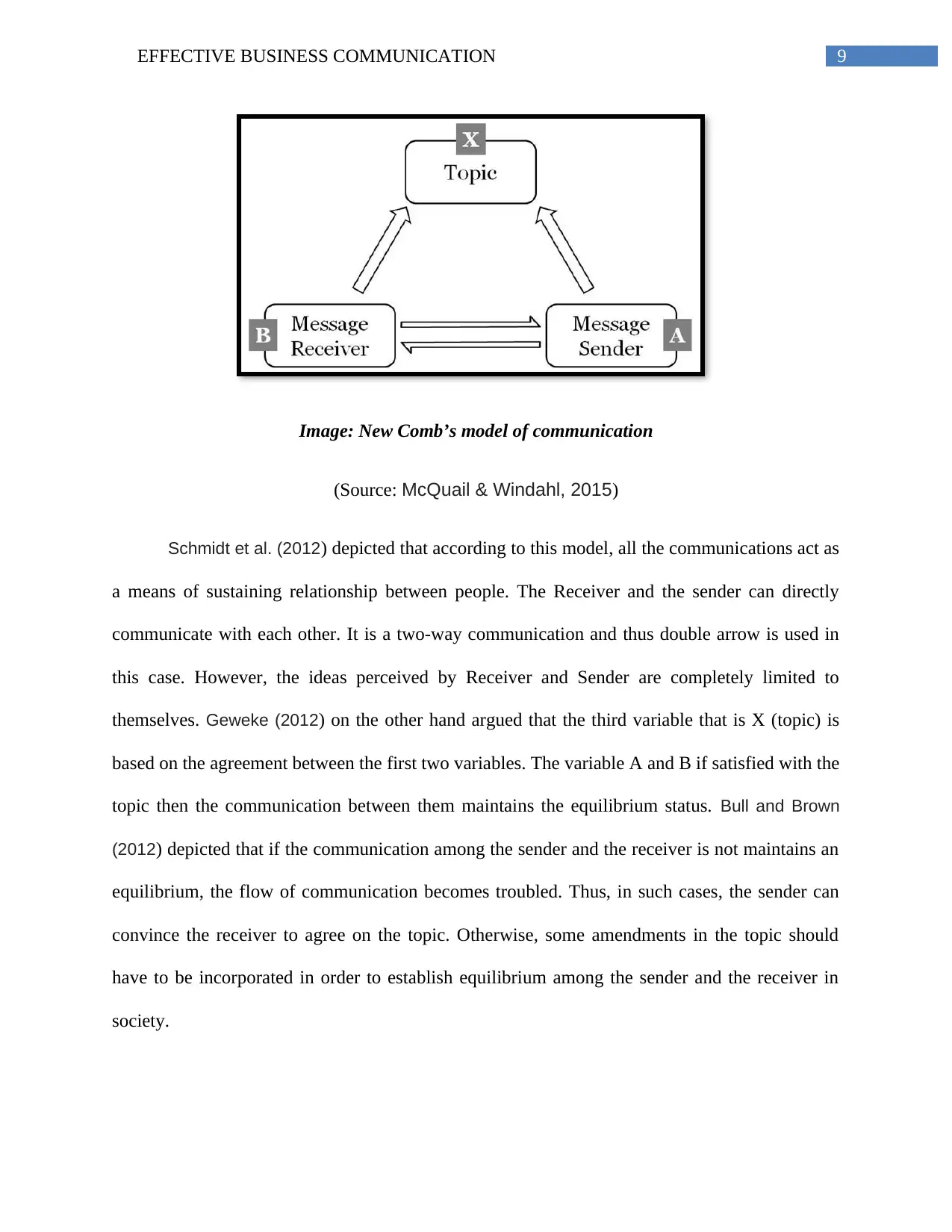
9EFFECTIVE BUSINESS COMMUNICATION
Image: New Comb’s model of communication
(Source: McQuail & Windahl, 2015)
Schmidt et al. (2012) depicted that according to this model, all the communications act as
a means of sustaining relationship between people. The Receiver and the sender can directly
communicate with each other. It is a two-way communication and thus double arrow is used in
this case. However, the ideas perceived by Receiver and Sender are completely limited to
themselves. Geweke (2012) on the other hand argued that the third variable that is X (topic) is
based on the agreement between the first two variables. The variable A and B if satisfied with the
topic then the communication between them maintains the equilibrium status. Bull and Brown
(2012) depicted that if the communication among the sender and the receiver is not maintains an
equilibrium, the flow of communication becomes troubled. Thus, in such cases, the sender can
convince the receiver to agree on the topic. Otherwise, some amendments in the topic should
have to be incorporated in order to establish equilibrium among the sender and the receiver in
society.
Image: New Comb’s model of communication
(Source: McQuail & Windahl, 2015)
Schmidt et al. (2012) depicted that according to this model, all the communications act as
a means of sustaining relationship between people. The Receiver and the sender can directly
communicate with each other. It is a two-way communication and thus double arrow is used in
this case. However, the ideas perceived by Receiver and Sender are completely limited to
themselves. Geweke (2012) on the other hand argued that the third variable that is X (topic) is
based on the agreement between the first two variables. The variable A and B if satisfied with the
topic then the communication between them maintains the equilibrium status. Bull and Brown
(2012) depicted that if the communication among the sender and the receiver is not maintains an
equilibrium, the flow of communication becomes troubled. Thus, in such cases, the sender can
convince the receiver to agree on the topic. Otherwise, some amendments in the topic should
have to be incorporated in order to establish equilibrium among the sender and the receiver in
society.
Paraphrase This Document
Need a fresh take? Get an instant paraphrase of this document with our AI Paraphraser
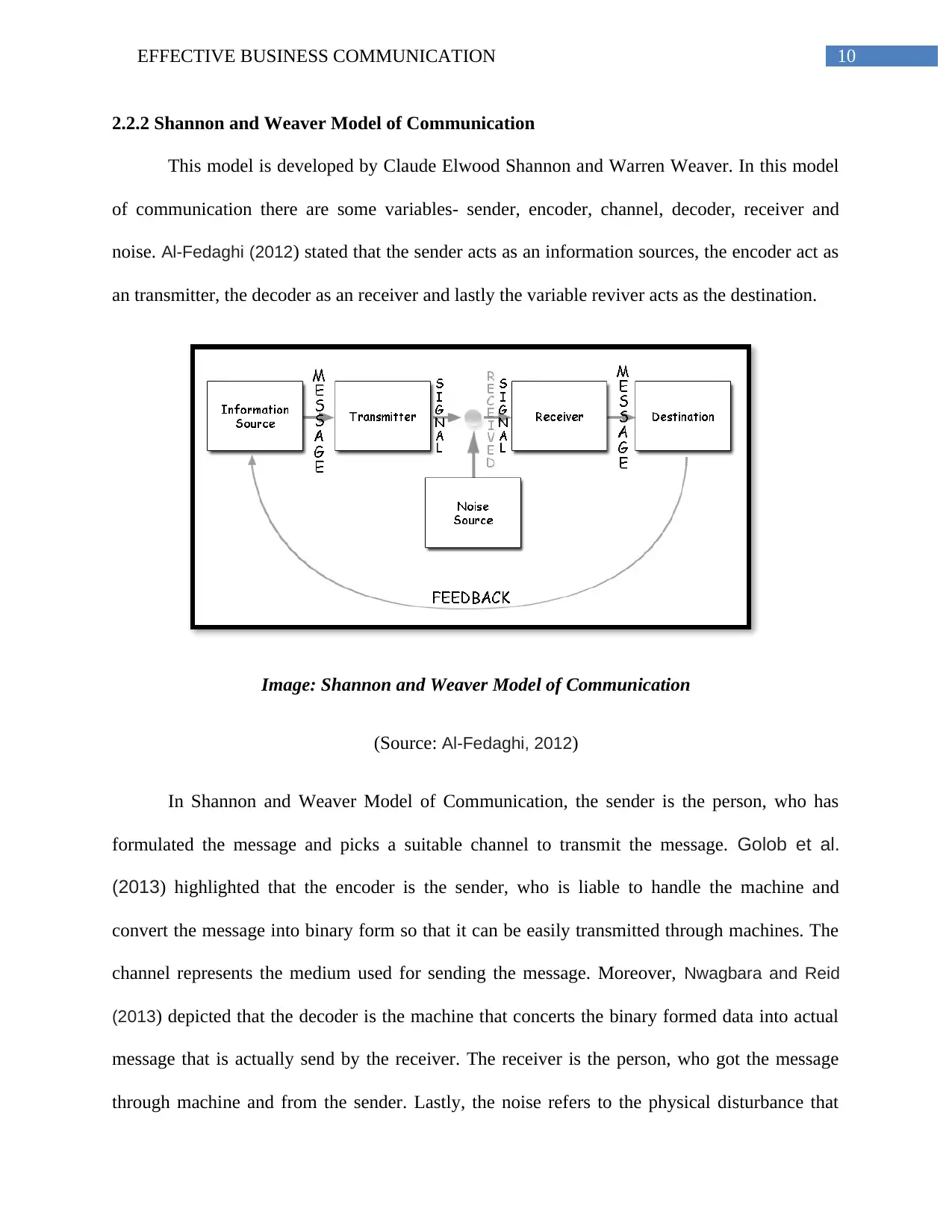
10EFFECTIVE BUSINESS COMMUNICATION
2.2.2 Shannon and Weaver Model of Communication
This model is developed by Claude Elwood Shannon and Warren Weaver. In this model
of communication there are some variables- sender, encoder, channel, decoder, receiver and
noise. Al-Fedaghi (2012) stated that the sender acts as an information sources, the encoder act as
an transmitter, the decoder as an receiver and lastly the variable reviver acts as the destination.
Image: Shannon and Weaver Model of Communication
(Source: Al-Fedaghi, 2012)
In Shannon and Weaver Model of Communication, the sender is the person, who has
formulated the message and picks a suitable channel to transmit the message. Golob et al.
(2013) highlighted that the encoder is the sender, who is liable to handle the machine and
convert the message into binary form so that it can be easily transmitted through machines. The
channel represents the medium used for sending the message. Moreover, Nwagbara and Reid
(2013) depicted that the decoder is the machine that concerts the binary formed data into actual
message that is actually send by the receiver. The receiver is the person, who got the message
through machine and from the sender. Lastly, the noise refers to the physical disturbance that
2.2.2 Shannon and Weaver Model of Communication
This model is developed by Claude Elwood Shannon and Warren Weaver. In this model
of communication there are some variables- sender, encoder, channel, decoder, receiver and
noise. Al-Fedaghi (2012) stated that the sender acts as an information sources, the encoder act as
an transmitter, the decoder as an receiver and lastly the variable reviver acts as the destination.
Image: Shannon and Weaver Model of Communication
(Source: Al-Fedaghi, 2012)
In Shannon and Weaver Model of Communication, the sender is the person, who has
formulated the message and picks a suitable channel to transmit the message. Golob et al.
(2013) highlighted that the encoder is the sender, who is liable to handle the machine and
convert the message into binary form so that it can be easily transmitted through machines. The
channel represents the medium used for sending the message. Moreover, Nwagbara and Reid
(2013) depicted that the decoder is the machine that concerts the binary formed data into actual
message that is actually send by the receiver. The receiver is the person, who got the message
through machine and from the sender. Lastly, the noise refers to the physical disturbance that
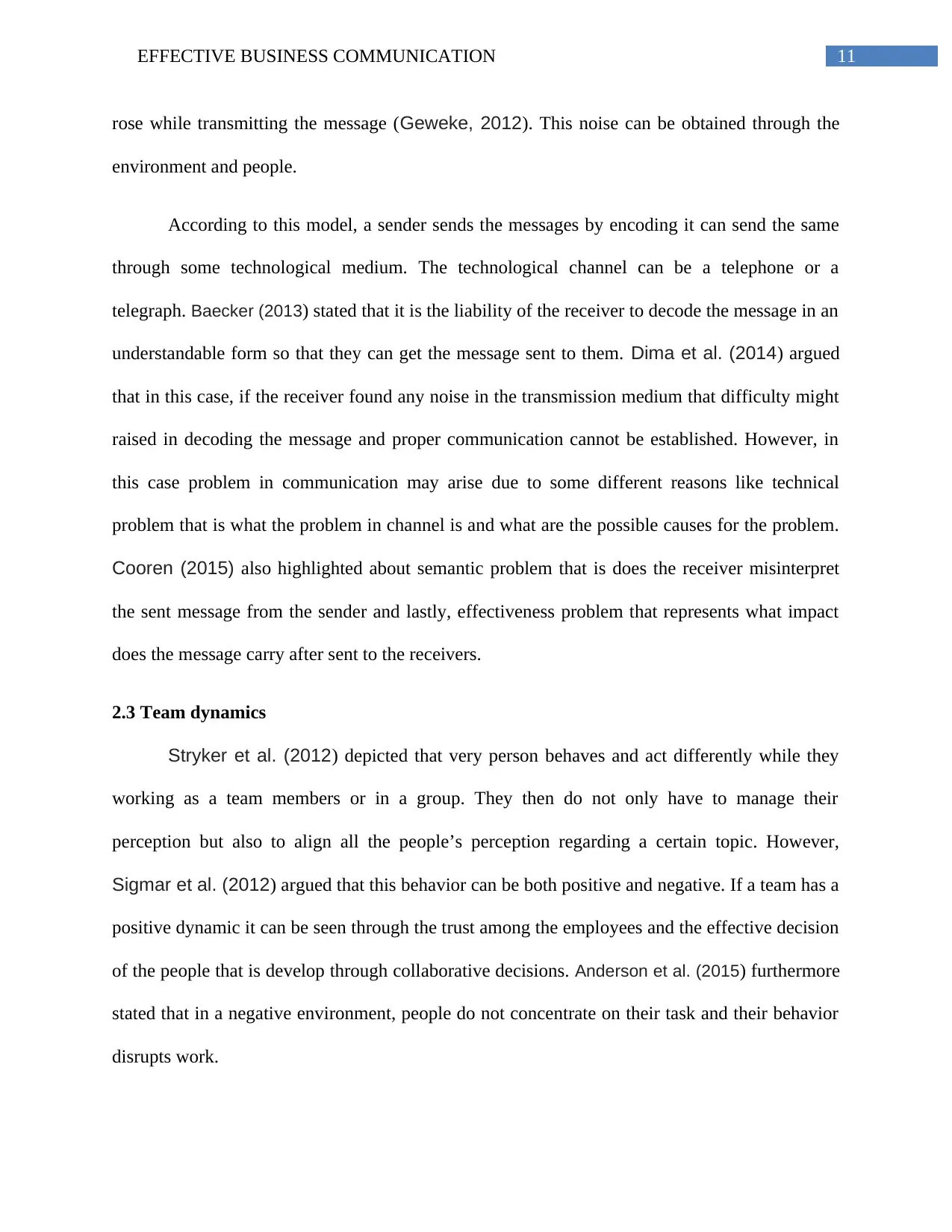
11EFFECTIVE BUSINESS COMMUNICATION
rose while transmitting the message (Geweke, 2012). This noise can be obtained through the
environment and people.
According to this model, a sender sends the messages by encoding it can send the same
through some technological medium. The technological channel can be a telephone or a
telegraph. Baecker (2013) stated that it is the liability of the receiver to decode the message in an
understandable form so that they can get the message sent to them. Dima et al. (2014) argued
that in this case, if the receiver found any noise in the transmission medium that difficulty might
raised in decoding the message and proper communication cannot be established. However, in
this case problem in communication may arise due to some different reasons like technical
problem that is what the problem in channel is and what are the possible causes for the problem.
Cooren (2015) also highlighted about semantic problem that is does the receiver misinterpret
the sent message from the sender and lastly, effectiveness problem that represents what impact
does the message carry after sent to the receivers.
2.3 Team dynamics
Stryker et al. (2012) depicted that very person behaves and act differently while they
working as a team members or in a group. They then do not only have to manage their
perception but also to align all the people’s perception regarding a certain topic. However,
Sigmar et al. (2012) argued that this behavior can be both positive and negative. If a team has a
positive dynamic it can be seen through the trust among the employees and the effective decision
of the people that is develop through collaborative decisions. Anderson et al. (2015) furthermore
stated that in a negative environment, people do not concentrate on their task and their behavior
disrupts work.
rose while transmitting the message (Geweke, 2012). This noise can be obtained through the
environment and people.
According to this model, a sender sends the messages by encoding it can send the same
through some technological medium. The technological channel can be a telephone or a
telegraph. Baecker (2013) stated that it is the liability of the receiver to decode the message in an
understandable form so that they can get the message sent to them. Dima et al. (2014) argued
that in this case, if the receiver found any noise in the transmission medium that difficulty might
raised in decoding the message and proper communication cannot be established. However, in
this case problem in communication may arise due to some different reasons like technical
problem that is what the problem in channel is and what are the possible causes for the problem.
Cooren (2015) also highlighted about semantic problem that is does the receiver misinterpret
the sent message from the sender and lastly, effectiveness problem that represents what impact
does the message carry after sent to the receivers.
2.3 Team dynamics
Stryker et al. (2012) depicted that very person behaves and act differently while they
working as a team members or in a group. They then do not only have to manage their
perception but also to align all the people’s perception regarding a certain topic. However,
Sigmar et al. (2012) argued that this behavior can be both positive and negative. If a team has a
positive dynamic it can be seen through the trust among the employees and the effective decision
of the people that is develop through collaborative decisions. Anderson et al. (2015) furthermore
stated that in a negative environment, people do not concentrate on their task and their behavior
disrupts work.
⊘ This is a preview!⊘
Do you want full access?
Subscribe today to unlock all pages.

Trusted by 1+ million students worldwide
1 out of 20
Related Documents
Your All-in-One AI-Powered Toolkit for Academic Success.
+13062052269
info@desklib.com
Available 24*7 on WhatsApp / Email
![[object Object]](/_next/static/media/star-bottom.7253800d.svg)
Unlock your academic potential
Copyright © 2020–2025 A2Z Services. All Rights Reserved. Developed and managed by ZUCOL.



